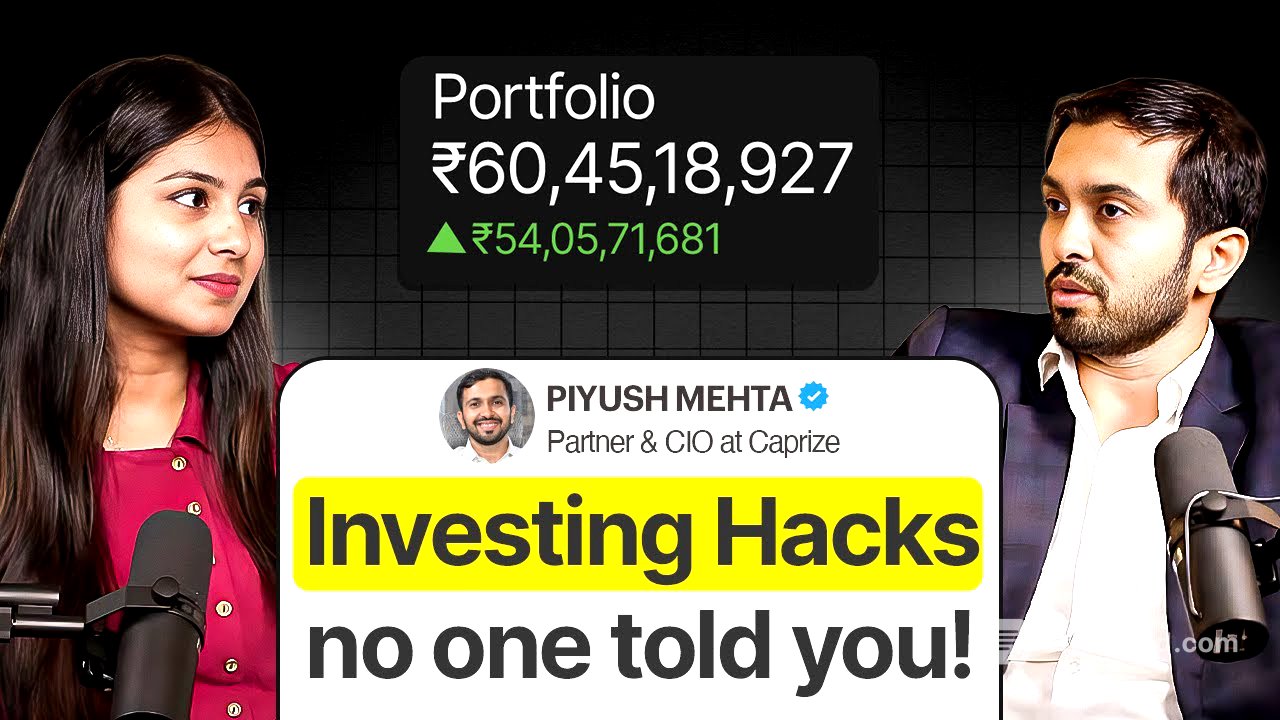TLDR;
This podcast features Piyush Mehta, CIO and Partner at Capriz Investment Managers, discussing his investment journey, philosophy, and strategies. Key takeaways include:
- Focus on your area of competence and invest in simple businesses.
- Always consider potential risks and downside before investing.
- Allocation and exit strategies are as important as the initial buy decision.
- Identify inflection points in companies and sectors for potential growth.
- Valueation is a fundamental benchmark for investment decisions.
Preview [0:00]
The preview highlights key points from the podcast, including examples of inflection points in companies like Apple and the importance of exiting investments at the right time. It also touches on the accessibility of smallcases for investors with limited savings and the need for a mindset shift towards seeking expert financial advice.
Introduction and Piyush's investing journey & philosophy [1:00]
Piyush Mehta shares his 16-year journey in the market, starting at the peak of the previous bull run in 2008. He emphasizes the importance of risk management, which was instilled in him during the financial crisis. His experience of traveling with CEOs, CFOs, and sector analysts gave him a 360-degree view of the market. A key learning from his journey is to always stay within your area of competence, assess potential risks before investing, and determine how much you are willing to lose. He also stresses the importance of simple businesses that are easy to understand and track.
Discussing the concept of inflection points [11:53]
Piyush explains that an inflection point is a turning point where growth accelerates significantly. He uses the example of a bamboo tree, which spends years developing its root system before growing rapidly. In investments, this refers to companies that have worked hard for 3-5 years and are now poised for significant earnings growth. He categorizes inflection points into four segments: fundamental, industrial/technological disruption, economic disruption, and mergers/acquisitions.
How to identify the inflection point in a company [17:18]
Identifying inflection points requires extensive reading and tracking of market trends. Piyush's team tracks 1000-1500 results every quarter, looking for industrial disruptions. He gives the example of the renewable energy sector, where government policies like the ALMM scheme caused a disruption by favoring domestic manufacturers. Similarly, the "Make in India" initiative in the defense sector led to significant growth. Currently, he sees potential disruptions in the water and data center sectors.
How to identify businesses worth investing in [23:10]
Piyush discusses how his team identifies businesses worth investing in when approached for capital. He emphasizes the importance of valueation and staying within their area of competence. He shares an example of a deal they rejected due to high valueation, even after thorough research. He stresses the importance of trusting your gut instinct and comparing a company's return ratios, margins, and order book visibility with its peers.
Which market cap or company type does Piyush focus on? [27:25]
Piyush focuses on micro and small-cap companies because they offer better access to management and simpler businesses to understand. He describes the typical journey of a successful company, starting as a microcap and gradually attracting larger investors. He shares the example of Gravita Recycling, where his team visited the facility, met with plant heads, and studied the business before investing. He also mentions a rule they follow: if a company is growing at 25% with a 30% return on capital employed, it will likely continue to rerate.
How to manage risk while investing [34:48]
Piyush emphasizes the importance of understanding what can go wrong before investing. He mentions that most of their investment reports focus on potential risks. They have a fixed framework for entry multiples and a 20% rule: if an investment falls 20% without a clear reason, they exit. He shares an example of Indiabulls Real Estate, where they cut their losses by following this rule. He also discusses a valueation mistake they made with Policy Bazaar and the importance of learning from such experiences.
Differentiating between long-term and short-term sectors/companies [41:20]
Piyush differentiates between momentum plays and long-term investments. For momentum plays, he looks at inflection points in the next four to six quarters, such as a company's capex or a new drug trial. However, he cautions that these are more difficult for normal investors due to the challenge of exiting at the right time. For long-term investments, he takes a top-down approach, identifying sectors with good prospects and then selecting companies within those sectors. He suggests that retail investors should not allocate more than 15-20% of their portfolio to micro and small-cap companies due to the difficulty of tracking them.
Rebalancing a smallcase portfolio [48:45]
Piyush explains that they rebalance their smallcase portfolios on a need basis, based on the four fundamental factors: fundamental changes, industrial disruptions, economic disruptions, and technological disruptions. He emphasizes that liquidity follows growth, not the other way around. When adding a new investment, they use a point system to determine which existing investment to remove, based on valueation and projected growth.
Discussing the SIF framework [50:35]
Piyush discusses SEBI's new SIF (Specialized Investment Funds) framework, which requires a minimum investment of ₹10 lakh. He expresses reservations about managing an SIF personally, as he believes it would be difficult to do justice to investors who are putting their entire net worth at stake. He prefers the smallcase platform, where he can manage a common portfolio for multiple investors without having to deal with them individually.
Piyush's message for investors [55:12]
Piyush advises investors to choose an investment style that suits their temperament and personality. He emphasizes that equity is a great tool for creating sustainable long-term wealth, but it should not be the primary focus for working individuals or business owners. He recommends finding trusted fund managers and diversifying investments. He also urges people to pay for professional financial advice, as it can help them avoid costly mistakes.
How FII flows have changed over time [59:20]
Piyush discusses the changing trends in FII (Foreign Institutional Investor) flows in India. He notes that FIIs used to drive the valueation of sectors and companies, but their relevance has decreased post-COVID. He explains that FIIs are chasing returns, and India's tax policies and currency depreciation make it less attractive compared to other markets. However, he believes that FIIs will eventually return, as India is expected to be the fastest-growing country in the world for the next 10 years.
Key sectors that contribute to a country’s growth [1:03:00]
Piyush identifies key sectors that contribute to a country's growth as it moves from a $3 trillion to a $10 trillion economy. These include consumer retail, premium healthcare, financial services, manufacturing, and power. He also mentions new sectors like data centers, AI, water, and renewable energy.
Conclusion [1:05:03]
The podcast concludes with Piyush thanking the audience and encouraging them to subscribe for more content.









